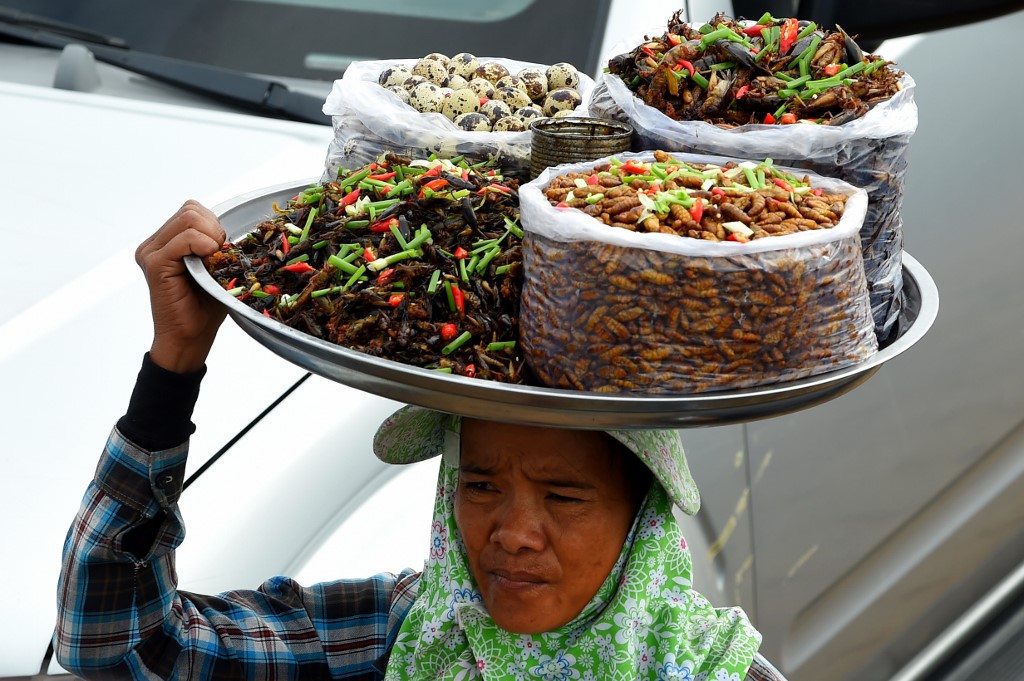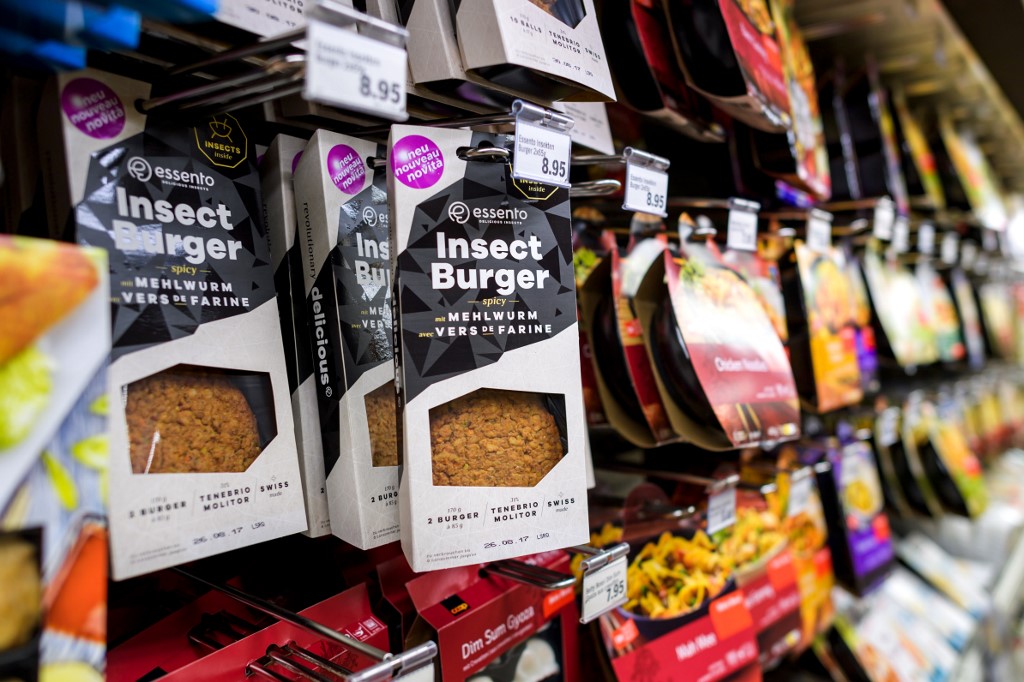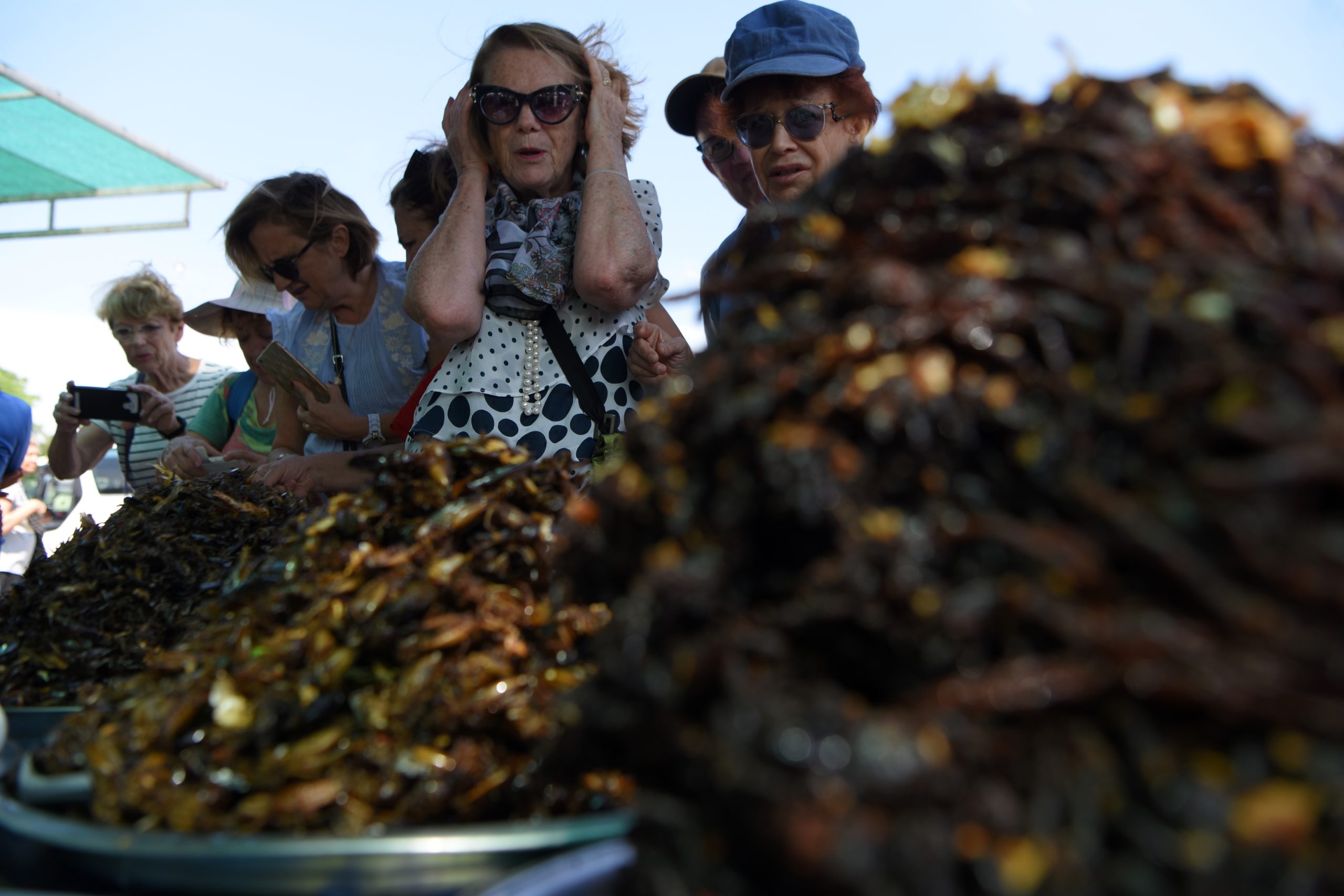On any given day, the massive cricket crouches beside the river, sunning its broad back atop its perch on the stone pedestal.
Luckily for any squeamish onlookers, the man-sized bug is just a statue, a loving rendition of a humble insect that plays a special role in the economy of Kampong Thom province in central Cambodia. The chirping insects make up an important harvest here, where they’re often seasonally caught wild or grown as a bumper crop by local farmers. Across Cambodia, these crickets are fried in oil and seasoned with sliced chilis and green onion to make for a tasty snack.
Though maybe unusual to European or North American consumers, there’s nothing novel about eating crickets in Cambodia, or really anywhere else in Southeast Asia. Crickets and other insects have long been eaten through the region as a provincial delicacy. But what is new is seeing insect-based food products appearing on supermarket shelves or under the sterile fluorescent lighting of a neighbourhood convenience store.
“We want to change the way Cambodians eat crickets,” said Chou Lundy, a founder of insect-based food startup Cricket House in Phnom Penh. “Right now, they only eat them deep-fried – very traditional.”
Along with her co-founder, Kun Kimlong, Lundy is betting that tastes can change here. Cricket House works with farmers to produce whole, dried crickets as well as cricket flour, a fine, protein-rich powder made from ground insects that can be used in cooking and baking.
As is, these offerings are really ingredients. But Kimlong says it’s a small step from cricket flour to cricket-based, ready-to-eat goods that can be sold and eaten on the spot.
“We’re thinking cricket snacks, protein bars, other things cricket as well,” he said.
Far from the rice fields of village life or the brimming, chili-spiced pans of a market vendor, the commercialised world of processed foods is the new frontier for insects in Southeast Asia. Dreams of a buggier urban diet have already seeded a global field of startups who swear by insects as the environmentally friendly superfood of tomorrow, a source of ready protein and other nutrients without the costly inputs, environmental impact and guilty feelings given over to cows, chickens and other livestock.

As their boosters are quick to say, insects could have the potential to change almost everything in the world of mass-produced food, offering a super-efficient option at a time when the planet is already teeming with more than 7 billion hungry human mouths. Researchers say one acre of black soldier fly larvae, a maggot commonly grown today to make feed for livestock, can produce more protein in a year than 3,000 acres of cattle or 130 acres of soybeans, all while eating almost any organic matter given to them. For those who work with edible insects, the question of whether they’ll be the next big thing isn’t a matter of if, but when.
Against that backdrop, investment bankers from richer countries have taken a new interest in what the UN Food and Agriculture Organisation says is already a dietary staple for about 2 billion people around the world.
In 2019, British finance house Barclays estimated the global insect market could be worth $8 billion by 2030 with an annual growth rate averaging at 24%. Late last year, the US agribusiness giant Archer Daniels Midland Co. announced its partnership with a French startup to build the world’s largest insect protein plant in the US to grow black soldier fly larvae for animal feed and other products.
But despite recurring media buzz, the mass acceptance of an insect diet has yet to catch on in the more formal marketplace of supermarkets and restaurants. And though young entrepreneurs at Southeast Asian startups like Cricket House have hopes of capitalising on local interest in insect foods as a kind of first-mover advantage in global markets, they’ll face stiff competition from emerging industry leaders – not to mention trade restrictions in major economies like those of the EU, a major potential market now developing regulations for bug-based products.
For the time being, that means keeping out most importers from their own growing industry.
“This [trade restrictions] is a gigantic barrier for startups in the developing world,” said Massimo Reverberi, founder of Bugsolutely, a Thai producer of cricket-based pasta.
Reverberi, originally from Italy, has been living and working in Thailand for more than 15 years, in which time he’s established a foothold in the edible insect market. Before the onset of Covid-19, he travelled from Bangkok between Asia and Europe in part to flog his brand and attend conferences with other players from the bug world.
Though he’s quick to disavow the technical term for eating bugs, entomophagy, as being overly weird, Reverberi is committed to the practice. Still, despite his enthusiasm, he notes several barriers ahead for the industry as a whole, both in Southeast Asia and beyond.
The first is just a matter of price point. For insects, the biggest market of interest may be in black soldier fly larvae, which are already used as a feeder crop for chicken and fish but aren’t often processed into food for humans. Then there are cockroaches, which are the preferred bug crop in China, where they’re grown by the billion in industrialised settings. Finally, the bug startups in the US and EU favour mealworms, while nutrient-dense crickets are generally the bug of choice in Southeast Asia.
Though raising those last insects is cheap compared to beef cattle or chicken, it’s not yet being done on a scale to bring cricket flour, the most marketable good, down to a price point that a snack producer would jump at. Barclays reports the price per kilo of cricket flour is falling considerably in most national markets, pointing to a 33% decline in Thailand from 2017-19. But even then, with an average price in Thailand of more than $20 per kilo, cricket flour still loses out for now to cheaper, plant-based protein powders.
“People will tell you it’s a nice idea for the future, but come back when it’s cheaper,” Reverberi said.
There are two worlds: One is traditional insect eating and one is processed, packaged food with insects as an ingredient. The two things don’t have much in common
The second issue the Bugsolutely founder has run into is getting major producers and distributors on board with what can still be regarded as an unusual or even gimmicky product. Without the credibility of being carried in a mainstream supermarket, cricket-based goods can find skepticism among shoppers and retailers alike.
For now, the actual producers of insects tend to be startups, which often means lots of potential without funding to match. While some key brands are investing exploratory funds for insect producers – such as in 2019 when the major seafood company Thai Union invested an undisclosed sum from its $30 million corporate fund into the Israeli fruit fly larvae firm Flying SpArk – the industry-wide investments just aren’t coming yet.
Finally, there’s the matter of knowing your customer. Though whole insects are already a common food for people around the globe, Reverberi doesn’t necessarily see much overlap with the emerging bug product market.
“There are two worlds: One is traditional insect eating and one is processed, packaged food with insects as an ingredient,” he explained. “The two things don’t have much in common. In Thailand, some Thai people eat insects as a tradition in the countryside, but these are whole fried insects. They’d never buy an energy bar with cricket flour, they’d never even consider it as they eat insects only for the taste, really. In the West, it’s marketed mostly as a super food, as an environmentally sustainable food.”

The fact remains that in Southeast Asia, rural consumers who want to eat whole insects don’t need to head to the supermarket to stock up.
Cambodia is no exception to this. The ground there for a full-scale insect industry was primed by a combination of traditional cricket farming and, more recently, development efforts from nongovernmental organisations such as Angka Changrit Kampuchea, or the Cambodian Cricket Farming Organisation, and the local office of nongovernmental organisation Danish Christian Association (DCA). Both promote efficient cricket cultivation and processing by smallholder farmers as a means of fighting poverty and rural food insecurity.
Today, the handful of Cambodian startups that reference this work from DCA include Cricket House and Ecologgie, both of which launched in 2019 and work with networks of independent farmers to source the insects for processing in Phnom Penh. On the finished product side, the capital is also home to EatCriche, a cricket-based snack line co-founded by Indranil Roy, a former technical advisor for Cricket House, that retails in Phnom Penh and online. Away from crickets, the local insect market also features Bug Bacon, a project run by longtime insect entrepreneur Josh Galt that bypasses crickets in favour of black soldier fly larvae.
Besides spreading best practices to farmers, Lundy and Kimlong from Cricket House have also been piloting an automated cricket habitat with sensor-controlled heat and humidity features. The founders hope to eventually scale up to a warehouse setting for mass cricket production as part of their long-term strategy of exporting to bigger markets such as the US.
Such a facility would be the first of its kind in Cambodia, where players across the agricultural sector are rushing to mechanise in a bid to keep up with their neighbours. Meanwhile, over the border in Vietnam, insect producer Cricket One is banking on using even more technology to stay ahead.
The company reportedly processes 100 million crickets per month in its heavily automated warehouses north of Ho Chi Minh City, where the basis of its own line of cricket products – including an insect-based burger patty – are grown, dried and ground into heaps of powder. Last year, that level of production caught the attention of Singaporean investment firm Corecam Capital Partners. With three other investors, the firm plugged a seven-figure infusion of capital into Cricket One to fund the company’s expansion.
Some people don’t know what to do with the cricket powder at first. But then we show them how to make different kinds of food and it can really go into anything
Founded in 2017, Cricket One is off to a strong start. But co-founder Bicky Nguyen said the fresh state of the industry in Southeast Asia means the playing field is more or less open.
“We would see ourselves as one of the major suppliers in the market rather than the market leader since it’s still a very young and relatively small market to really set positions,” she said in a message.
For now, the company is focusing on developing new cricket-based products with an eye to meat substitute products – a $20 billion and growing category mostly filled today by soy and other plant foods.
Cricket One’s biggest markets today are in the US and Japan, and though hurdles remain to get access to the EU, Nguyen was optimistic about her company’s chances.
Back in Phnom Penh, Lundy and Kimlong say they’re busier than ever tending their own company, building out their supply chain, and developing their own range of products. Even in a country where crickets are a familiar food, the new goods take some getting used to in the marketplace.
“Some people don’t know what to do with the cricket powder at first,” Kimlong said, describing the domestic market. “But then we show them how to make different kinds of food and it can really go into anything.”


